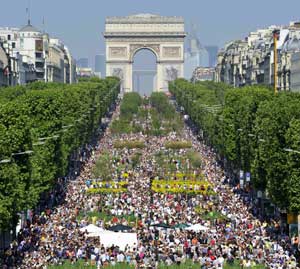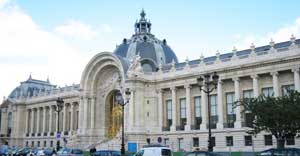If the Champs Élysées were a rose, it would have long ago lost it's bloom.
This area is Paris at its most 'bling' but while in the past it was the classy bling of 24 carat diamond, today it is the brash sparkle of diamante.
But thats not to say that the Champs Élysées and the 8th arrondissement have ceased to be frequented by millions of tourists, quite the opposite.
Do the Champs Élysees need all this introduction at this point? Probably not. It is one of the most famous streets in the world. That makes it the second most expensive strip of real estate in Europe, surpassed only by London's Bond Street.
In recent years some of those luxury shops have been replaced by giant chain stores but we think there are two ways to look at this: either it is a violation of the essence of Paris or it just means that the Champs Élysées has become a bit more accessible.

For a taste of what Paris is like for the excessively rich, take a stroll down the rue du Faubourg St-Honoré or Avenue Montaigne. Most of the top brands in the world have boutiques here: Chanel and Yves Saint Laurent rub shoulders with Hérmes and Gucci. Warning: walking down the street and window shopping may be free, but just to enter these shops you will probably have to remortgage your house.
In a similar vein, the Champs Éylsées area is full of Paris's best (and obviously most expensive) hotels.
If you are looking for a bit of old-school glamour and luxury then it doesn't come much better than the Four Seasons Hôtel George V or the Hôtel Plaza Athénée which has an Eiffel Tower view from every room. Sadly though it follows that if budget accommodation is what you want, this is not the area to look in.
As well as providing high-end everything, the Champs Élysées is also home to some of Paris's cultural highlights. Crowning the great boulevard is Napoleon's monument to himself, the Arc de Triomphe, and at the other end of the street the majestic Grand Palais plays host to some of the city's best art exhibitions. The Petit Palais has a permanent art collection which is free to visit and if you want a taste of something completely different the Russian Cathédrale Alexandre-Nevsky is spectacular.
After you have grown tired of the bright lights and impossibly perfect trees of the Champs Élysées, this neighborhood still has a lot more to offer. While it may just look pretty and superficial on the outside, the 8th arrondissement really does have the substance to back it up.
Champs Élysées hosts a variety of cultural attractions including several art museums in its northern corners; they are often located in hotels particuliers, meaning that not only is the art collection worth going for, but the buildings themselves as well.
If the bustle of the city is all getting a bit too much, take refuge in Parc Monceau or if you fancy wandering around a cathedral with a difference the Cathédrale Alexandre-Nevsky could be the perfect place.
Arc de Triomphe
This monumental arch may have been built by one short Frenchman to celebrate his own military brilliance but it now has a much more sentimental significance than that. Today the Arc de Triomphe is dedicated less to just Napoleon, and more to all French army soldiers and veterans. The Tomb of the Unknown Soldier, is situated under the arch and was added to the structure on 11th November, 1920. An eternal flame illuminates the tomb, which is rekindled every evening at 6.30pm. It has recently been renovated and made more visitor friendly - for more information visit the Arc de Triomphe attraction page.
Grand Palais
The Grand Palais was built, along with the the Petit Palais, for the 1900 World Fair and they were never supposed to be permanent. Luckily someone forgot to tear them down so now, over a hundred years later, we can enjoy the stunning Art Nouveau architecture. The exhibitions staged here have a reputation for being the hottest tickets in town and so it pays to buy advance tickets if something catches your eye.

Petit Palais
Also known as the Musée des Beaux-Arts de la Ville de Paris, the Petit Palais plays host to an excellent permanent exhibition of French painting and furniture as well as the largest public collection of Christian Orthodox icons in France. The temporary exhibitions are well received as well and the building - a dream in white marble and gilt - boasts fantastic views of the Seine from its enormous windows. In the courtyard is a gorgeous exotic garden that displays more of the grandiose architecture and is the café is the perfect place to rest weary feet.
Parc Monceau
The garden that hides behind the impressive, gold-tipped gates is slightly out of the way which tends to make it locals only, especially local families. Kids love to explore the hiding places and there is plenty of shade to be had thanks to the largest tree in Paris: a platanus orientalis, 7m thick and two centuries old. The best thing is that even though the signs say “Pelouse interdite” (keep off the lawn), on sunny days, everyone is mysteriously illiterate.
Cité de l'Architecture et du Patrimoine
This museum was reopened in 2007 to much fanfare after 10 years and $114 million had been spent refurbishing it. Luckily for them, the result is one of the best architecture museums in the world. It was formerly the French Monuments Museum but now the 86,000 square feet of gallery space is filled with some 350 plaster-cast replicas of the best French architecture has to offer. There is even an interactive room to entertain energetic kids.
Cathédrale Alexandre-Nevsky
Known as the Église Russe, this lavish cathedral is Paris's home to all things Russian. The church was built in 1861 and is named for a Russian national hero, Alexandre Nevsky did heroic stuff during Russia's war with Sweden in 1240. The interior was originally painted by artists from St-Petersburg in gold, reds, blues, and greens in classic Byzantine style and has been recently superbly restored. The church also boasts an altar that dates from 1289 and and is thought to have been (ahem) blamelessly liberated from another church during the Napoleonic Wars. Interesting fact: Picasso married the Russian ballerina Olga Khokhlova here in the summer of 1918.